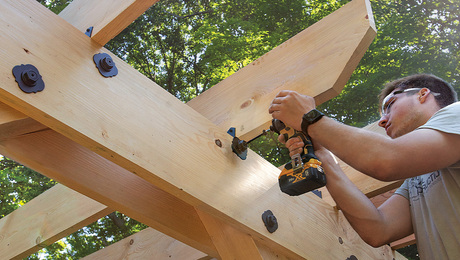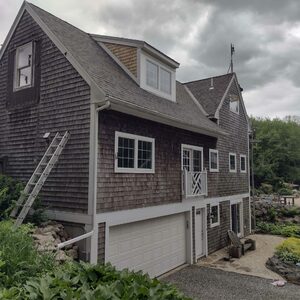Fine Homebuilding has presented many methods of affixing deck boards to joists, However a method they have not presented is one I have used to build a few decks. It involves drilling angled holes into the joists themselves prior to the boards being laid on top so that a 3″ deck screw can be tightened from below pulling the deck board tight atop the joist. This method requires under deck access at the very last board, as you can sit inside the joists and tighten each one as it goes down. This method avoids costly deck fastening systems, and putting hundreds of holes into the deck boards, leaving a very nice finish. However what do more experienced deck builders, engineers think of this?
-Paul
Discussion Forum
Discussion Forum
Up Next
Video Shorts
Featured Story

Built from locally sawn hemlock, this functional outdoor feature uses structural screws and metal connectors for fast, sturdy construction.
Highlights
"I have learned so much thanks to the searchable articles on the FHB website. I can confidently say that I expect to be a life-long subscriber." - M.K.
Fine Homebuilding Magazine
- Home Group
- Antique Trader
- Arts & Crafts Homes
- Bank Note Reporter
- Cabin Life
- Cuisine at Home
- Fine Gardening
- Fine Woodworking
- Green Building Advisor
- Garden Gate
- Horticulture
- Keep Craft Alive
- Log Home Living
- Military Trader/Vehicles
- Numismatic News
- Numismaster
- Old Cars Weekly
- Old House Journal
- Period Homes
- Popular Woodworking
- Script
- ShopNotes
- Sports Collectors Digest
- Threads
- Timber Home Living
- Traditional Building
- Woodsmith
- World Coin News
- Writer's Digest


















Replies
Seems like a good idea. You could use a pocket hole jig to get each one perfectly centered too.
Legal Disclaimer: The preceeding comments are for entertainment purposes only and are in no way to be construed as professional advice. The reader of these comments agrees to hold harmless the poster, EJCinc, from any and all claims that EJCinc offered professional advice, ideas, or comments to the reader that may or may not have resulted in the damage, injury, or death to the readers property or person.
Not sure if I understand correctly, but it sounds like you'd be encouraging the tops of the joists to split off. What you're doing is sort of like toenailing, but that's usually done parallel to the grain, not across. I wouldn't try that with the hem/fir PT we get here. If you're alternating screws from opposite sides of the joist it would certainly be better than running them all from the same side.
The poster may have gotten his start installing laminate countertops.A great place for Information, Comraderie, and a sucker punch.
Remodeling Contractor just outside the Glass City.
http://www.quittintime.com/
Innovative for sure, but seems to be a bit labor intensive.
& if you're using a 4/4 or a 5/4 decking material that's not a lot of board there to get a good bite on.
I like the Ebty, & tiger claw systems, even though they are not cheap.
Trying to save a buck on a 400 square foot IPE deck I built for a customer I used a SS fender washer with a SS deck screw---- too labor intensive aligning the washer to go into the dado ripped into the IPE.
Since it was a "hard" bid what I saved in material I lost with my hourly rate dropping.
Cedar, sun wood, & PT decks I like to use GRABBER screws, if the customer wants a non hidden fastening system. I wouldn't recommend them for the Brazilian swamp woods ( IPE, Jatoba, & others) have to pre-drill & counter bore.
“Well, the election campaign in the country is picking up speed... All the candidates are talking about health care now. Don’t they realize that it’s their campaign speeches that makes us sick?” —Bob Hope
i agree with david, and its a great idea by the way, you are "toe" screwing which is an excellent way of attachment, more holding power than straight in, but
like david says you are subjecting the top of the joist to all that holding power you are applying. if you are careful, watch what you are doing placing screws, stagger the screws it would be a great installation.
i also think very labor intensive, there is nothing wrong with just nailing it down in my opinion, some of the docks use short nails on purpose so in a storm the deck boards come off and the structure isn't damaged.
if the nails come up its easy to reset them, if a few get way loose and keep popping replace those few with screws, when it comes time to replace deck boards you will look like a genius. decks do have a shelf life, it should be planned for, or at least considered. you don't want them to stay screwed forever.
Instead of drilling the tops of the joists, I screw a 2x4 on top of the joist centered on it. The joist will look like a T.
Then you can screw your decking through the 2x4 underneath.
That's a really simple alternative I hadn't thought of. I suppose the only downside might be a greater surface for pine needles and other debris to collect on. My experience here in the PNW with decks is that the beams rot first, then the joists from the top where water penetrates the fastener holes. The 2"x 4" probably protects the joists pretty well, acting as a sacrificial cap that can be replaced without monkeying with the structure.
It's a decent idea I thought of one day, the HO didn't want to see any screws so thats what she got. It's a little time consuming, but it's generally a wash compared to the expensive hidden deck fasteners.
Be sure to mount ledger low enough for the extra 1-1/2".
We do that on our seams on long decks, or when we can use own normal fastners. Helps hold it in place.
clinkard,
reminds me of a system (which I can't recall the name of) that is made of short metal sections (3' or so) that look like a piece of corner bead with a short leg added on one side, this "corner bead" is fastened to the side of the joist, the deck board is then fastened from below up through the perforations in the "corner bead" into the bottom of the deck board. Like your method, this requires access from underneath but you aren't drilling all those hole in the joists and you could probably have a person underneath and move right along.
maybe someone else recognizes the system?
Geoff